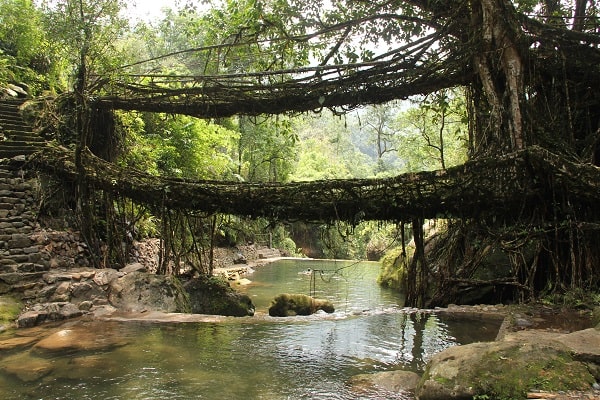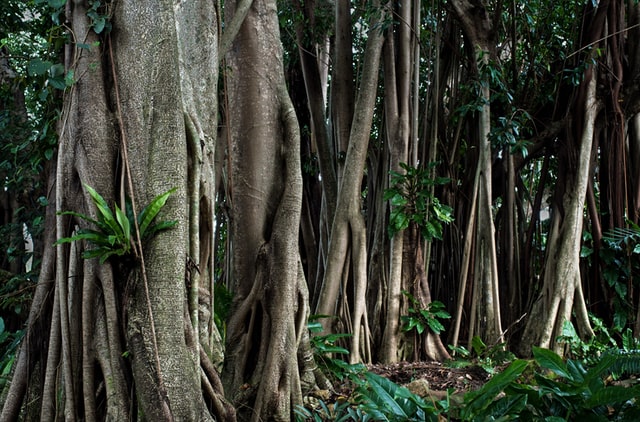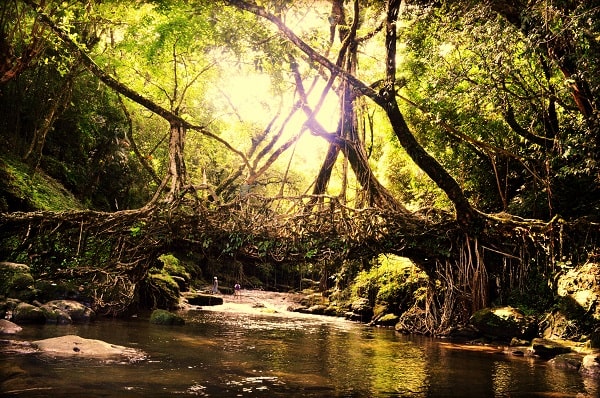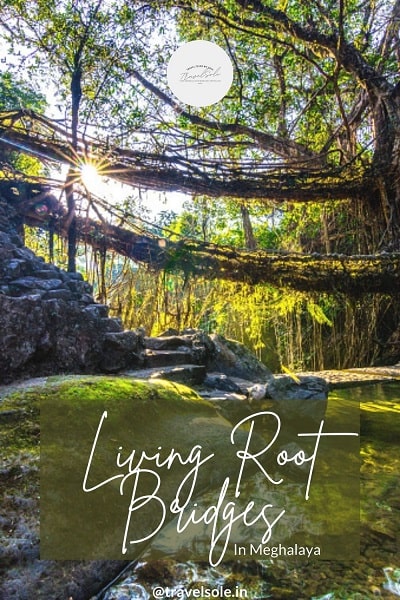India is home to some of the most incredible natural wonders on earth. One such wonder are the living root bridges in Meghalaya, which have been around for centuries.

Living root bridges are natural bridges that are created and maintained by the Khasi people of Meghalaya, India. The bridges are made from the aerial roots of Ficus elastica, a rubber fig tree. The roots are trained to grow around and between two supporting trees, eventually fusing together to form a strong bridge. The living root bridges can span distances of up to 100 feet and can hold the weight of 50 people.
The roots grow down from one tree and attach to another tree, forming a bridge across a river or ravine.
Today, we discuss these wonderful living root bridges and their story – the history, mystery and everything you need to know about it.
Living root bridges in Meghalaya
There are approximately 100+ living root bridges in Meghalaya that have been found. They mostly exist in and around the 72 villages at the East Khasi Hills and West Jaintia Hills in the region. Recently, the living root bridges of Meghalaya have been granted a tentative space as one of UNESCO’s World Heritage Sites.

With that large number of tree bridges located in the state, Meghalaya is itself sometimes referred as the Living Root Bridge of the world.
Over centuries, the tribal people of Khasi and Jaintia Hills practiced and mastered the art and tactics of conjoining or wrapping two or more thick roots of the rubber tree together and forming a structure capable of holding around 50 people over it. I mean if that’s not something unique and applaudable, I’m not sure what is.
Some of the Meghalaya living root bridges are approximately 500 years of age and still hold more than 30-35 people crossing over it. You can simply say that the root bridges stand strong for centuries from when they are made. The interesting thing is that in Meghalaya’s forests – bridges are not built, but grown.
Some of the most famous living root bridges in Meghalaya
As mentioned earlier, there are approximately more than a 100 living root bridges found over 72 villages in Meghalaya and all of these are a natural wonder and feels as if they are all made out of pixey dust and magical potions.
- Umshiang Double Decker Root Bridge
Location – Nongriat Village (near East Khasi Hills)
Length – 70m
USP – Most popular and oldest living root bridges in Meghalaya.
- Mawsaw Root Bridge
Location – Mawsaw Village
USP – Natural swimming pool
- Rittymen Root Bridge
Location – Nongthymmai Village
Length – 30m
- Umkar Root Bridge
Location – Umkar Village
*Still under construction* but visitors still visit here to view the process of the growing of the root bridges.
How are they made?
Now that we know what basically are the living root bridges, let’s discuss just how did the Khasi and Jaintia tribes figured it all out and made it.
The History

The first thing to know before we go into the history of the living root bridges is to know that we are talking about Meghalaya – the state with the most amounts of rainfall and thus, the wettest place in the world. As per stats, a village called Mawsynram (located at the southern slopes of Khasi Hills) receives about 467 inches of rainfall annually.
As per the statistics, the average annual rainfall in Meghalaya is about 452 inches.
So, centuries ago – during monsoons, the rain used to flood the forest areas so much so that the tribal people from small villages or from the deep forests got trapped in their areas and could not move for food and stuff for a large period of time.
To counter this issue, the Khasi people initially build bridges out of bamboos – by putting out a few bamboos together. But the effort went in vain once the storms came in. The rough storms would end up decaying the bamboo structures and it would be of no use.
The next step the Khasi people decided to take is making a bridge from the Indian rubber fig tree. Now the rubber tree has aerated roots which means they can be tied, twisted and shaped up into a strong structures.
So that’s what the tribal people started working on – making a stable and strong root bridge for crossing to and from the places around for livelihood tasks. But it took them approximately 10 to 30 years of hard work and wood shaping and root twisting to get the first glimpse of the bridge.
Even though it took time, once the bridge was full formed – it would now live for centuries unharmed by the rain, the roughest of the storms and anything wild.
The living root bridges formed a way for the villagers and the tribal people of Khasi and Jaintia hills along with all the people and animals crossing through the forest, especially during the hard hitting monsoons.
The Process
The process of creating this natural wonder – made by humans has a few steps. First and foremost of those steps is to plant the trees at both sides of the riverbank.

Next, the roots of the rubber tree are twisted and thread together to make a tentative or makeshift bridge for passages. This step guides the roots to move towards the other side of the river.
Next, as the roots start to grow with time – they reach the other sides of the river and attach themselves together to form a strong holding structure above the river.
Lastly, when the roots are strong enough, they become stronger and thus the full fledged structure of a living root bridge is completed.
The entire process is natural (except for initially planting the trees) and the roots find their way to the other plant/tree and mingles with it. It is a time taking process, but it’s all worth it.
As the years progressed, the locals used different techniques as well to try and make the bridges more unique and strong. These were –
- Training the rubber tree roots to flow over the scaffolds of wood or bamboo trunks making the bridge stronger.
- Training the rubber tree roots to go through the large hollow trunks of the Areca nut palm trees. The trunks provide the roots with nutrients and protection from decay.
What is their purpose?
The major purpose of the living root bridges in Meghalaya was to make a passage for the tribal and villagers to move freely across the forest and towards other villages for necessary purposes. The monsoons could no longer make them stay put for a large period of time and they could work and maneuver whenever and wherever.

Centuries later, some tourists discovered it and though to themselves “what an outstanding natural wonder – everyone shall see it” or something along those lines. And slowly, the hard work of the Meghalayan tribes got recognition and people started to come visit these villages and forests to see and experience the structure for themselves. This gave the local people the appreciation and recognition of the years and centuries of work they put into making passages for everyone.
The living root bridges of Meghalaya are one of the most interesting, intriguing and outstanding structures ever developed and one among the most fascinating collaboration between human and plants.
The longest known living root bridge exists near a small Khasi town called Pynursla and is about 50 meters long.
The major purpose of these fascinating living root bridges, today is both – the passageway for local people and an interesting catch for travellers and explorers.
The benefits of ficus elastica

There are many benefits of the ficus elastica or the rubber tree used to construct the living root bridges in Meghalaya, let’s discuss those –
- It purifies the air around it and makes sure the environment is clean
- It is easy to grow and can be kept in your houses as well
- It needs very low maintenance
- It’s roots can shape up into becoming one of the most incredible and strong bridge structures
The Umshiang Double Decker Root Bridge Trek
The double decker living root bridge is called as the most famous root bridge in all of Meghalaya.
These are essentially the same structures and feels as if someone went to photoshop and copy-and-pasted a root bridge structure a couple of meters above the one already there. But it wasn’t that simple, of course.

Double Decker Living Root Bridge
Reaching these double decker living root bridge is not easy – there’s a rough trek involved. And that is another reason why it attracts major tourist population.
The Umshiang Double Decker Root Bridge is located over the Umshiang river offers an exciting trekking descent to the “holy grail” of all root bridges in the state. You can start the trek from Cherrapunji but it advised to start from a placed called Tyrna village (about 12 kilometers distance). The trek distance becomes lesser and it takes approximately 4 to 5 hours to explore the natural trail and the destination.
Trekkers shall be ready for some nerve recking adventure into the 3000-step journey to reach the incredible destination. The trek is filled with adventures of the wild and mesmerizing views of a (rainbow) waterfall, splendid blue rivers and wildlife.

The trek is basically a 3-step journey –
- First Step or part of the trek is the most challenging as you go down hill to Nogthymmai village. This step takes you deeper and deeper into the forest.
- Second & Third Step are much easier and relaxing and one can take their time exploring the village and the natural trails and incredible nature experiences the forest offers.
The trek might seem dangerous as you get there, but when you get to the destination – to the double decker root bridge, all that fear, pain and everything just vanishes. It feels as if you’ve somehow travelled through a portal to a world of magic!
Stay Options
Due to the number of visitors the place saw overtime, you may also find small vendors providing snacks on the go. You may find homestay or dormitory options near the bridge as well.
Stay options around there are no worries, you can stay in or near Cherrapunji or for a more local experience you may also stay at one of these fascinating villages of Meghalaya. The people are very calm and have plenty stories to tell.
Do not forget to visit the rainbow waterfalls, located about 2 kilometers from the bridge. It is a mesmerizing view when you reach at the best time for looking at the rainbow being formed just across the blue waterfall.

FAQs
Best time to visit? April to June | December to February.
Is the trek difficult? Yes. The trek is long, tiring and can be challenging for people.
How Long is the Trek? It takes about 2 to 3 hours (maybe more) to fully complete the trek.
How many steps? 3500 steps from Tyrna Village.
How to reach Tyrna Village? Take cab from Shillong to Tyrna Village (65km|2hours).
Conclusion

There ends another blog about an interesting place to explore around the world. I hope you liked the blog explaining the natural wonder of the Living root bridges In Meghalaya as much as I liked writing about it.
Leave a comment if you liked the article and follow us on the socials to get to know TravelSole better. I would appreciate if you share this article to the people who would love to read about this marvelous wonder.
That’s All Folks!

[…] skies to oceans flowing to the deepest spaces. From dried up desserts with a hypnotic charm to the wettest place on earth. From the most deep routed rural lands standing with the historic values and traditions of the […]
[…] living root bridges, hundreds of trekking and hiking opportunities, the unique people of the whistling village and so […]